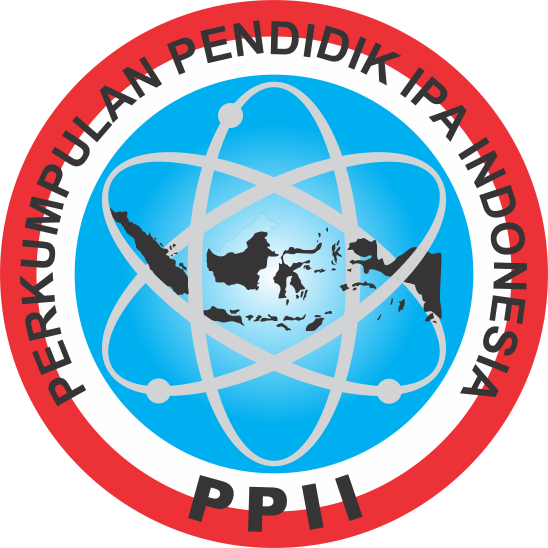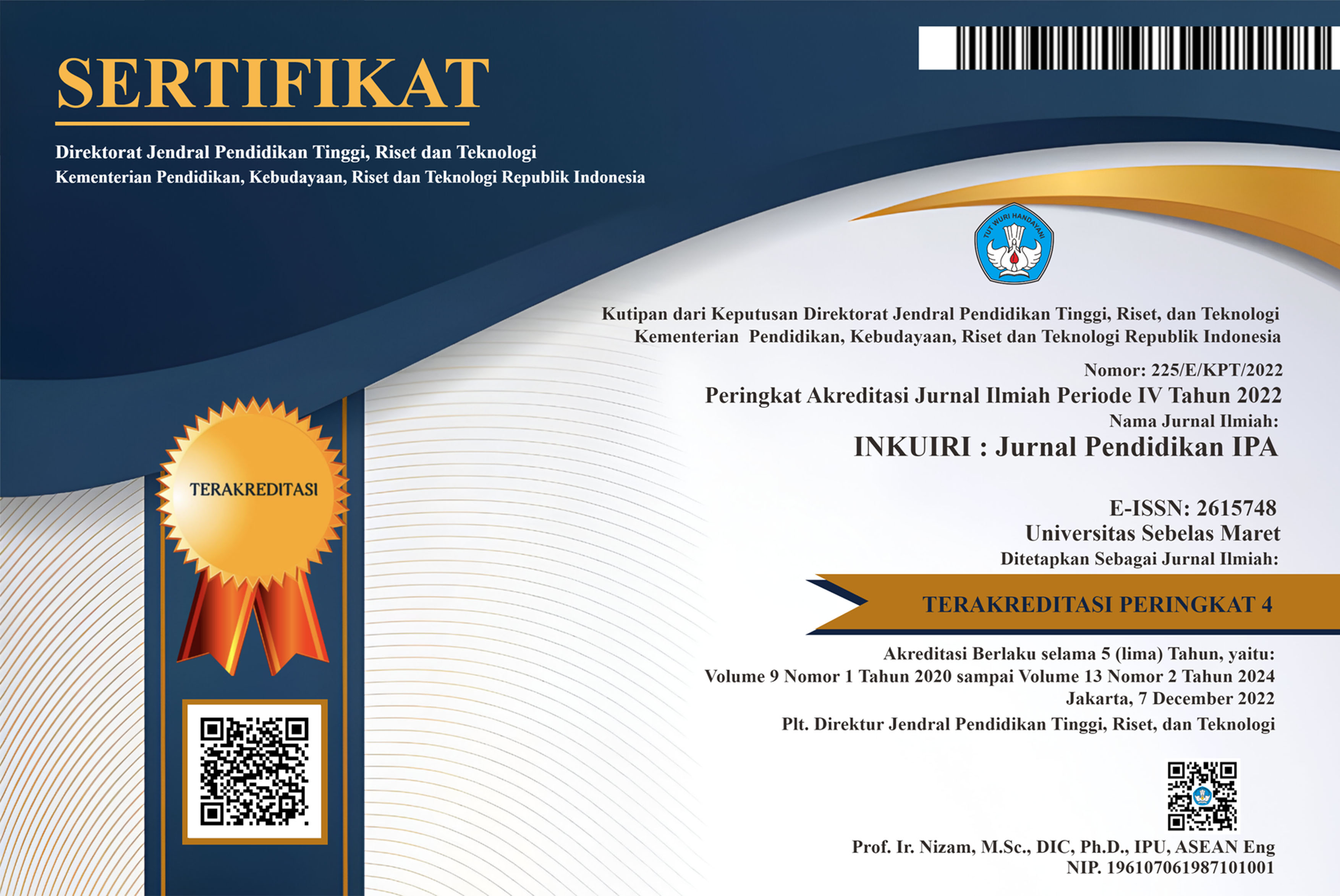THE LEARNING OF RESPIRATORY SYSTEM: IMPROVING STUDENTS’ CREATIVE THINKING SKILLS THROUGH PROJECT-BASED LEARNING
Abstract
Keterampilan berpikir kreatif merupakan keterampilan krusial yang dibutuhkan oleh generasi saat ini dalam menghadapi tantangan abad ke-21. Penelitian yang berfokus pada keterampilan berpikir tingkat tinggi masih terbatas. Penelitian ini bertujuan untuk menganalisis pengaruh RPP pembelajaran berbasis proyek sistem pernapasan terhadap keterampilan berpikir kreatif siswa. Desain penelitian pretest and posttest dengan kelompok kontrol non-equivalent. Perlakuan yang diberikan pada kelas eksperimen adalah penerapan RPP berbasis proyek sistem pernapasan, sedangkan kelas kontrol menggunakan metode yang biasa digunakan oleh guru. Hasil penelitian ini menunjukkan bahwa kemampuan berpikir kreatif siswa kelas eksperimen lebih tinggi secara signifikan dibandingkan kelas kontrol. Kesimpulannya, RPP pembelajaran berbasis proyek sistem pernapasan efektif dalam meningkatkan kemampuan berpikir kreatif siswa.
Creative thinking skills are the crucial skills required by nowadays generation in dealing with the 21st Century challenges. The researches focused on higher order thinking skills are still limited. This study aimed to analyze the effect of respiratory system project-based learning lesson plan on students’creative thinking skills. The research design was pretest and post-test with non-equivalent control group. The treatment given in experimental class was the implementation of respiratory system project-based learning lesson plan, while the control class was taught using common method used by the teachers. The results of this study indicated that the students’ creative thinking skills in experimental class was significantly higher than the control class. In conclusion, respiratory system project-based learning lesson plan is effective in improving students’ creative thinking skills.Keywords
Full Text:
PDFReferences
Adam, R. G., & Gullota, T. (1983). Adolescent Life Experiences. California: Brooks/Cole Publishing Company.
Ahmad, D. N., Astriani, M. M., Alfahnum, M., & Setyowati, L. (2021). Increasing creative thinking of students by learning organization with steam education. Jurnal Pendidikan IPA Indonesia, 10(1), 103–110. https://doi.org/10.15294/jpii.v10i1.27146
An, D., Song, Y., & Carr, M. (2016). A comparison of two models of creativity: Divergent thinking and creative expert performance. Personality and Individual Differences, 90(February), 78–84. https://doi.org/10.1016/j.paid.2015.10.040
Anazifa, R. D., & Djukri. (2017). Project- based learning and problem- based learning: Are they effective to improve student’s thinking skills? Jurnal Pendidikan IPA Indonesia, 6(2), 346–355.https://doi.org/10.15294/jpii.v6i2.11100
Andersen, H., & Hepburn, B. (2015). Scientific Method. The Metaphysics Research Lab. Stanford Encyclopedia of Philosophy. https://plato.stanford.edu/entries/scientific-method/
Arti, Y., & Ikhsan, J. (2020). The profile of Junior High School students’ critical thinking skills and concept mastery level in local wisdom based on outdoor learning. Journal of Physics: Conference Series, 1440(1).https://doi.org/10.1088/17426596/1440/1/012105
Bakir, S., & Öztekin, E. (2014). Creative thinking levels of preservice science teachers in terms of different variables. Journal of Baltic Science Education, 13(2), 231–242.
Bender, W. (2012). Project-Based Learning Differentiating Instruction for the 21st Century. United States of America: Corwin a Sage Company.
Bono, E. de. (2014). Creative and Lateral Thinking. Encyclopedia of Educational Theory and Philosophy, June.https://doi.org/10.4135/9781483346229.n86
Ergül, N. R., & Kargın, E. K. (2014). The Effect of Project based Learning on Students’ Science Success. Procedia - Social and Behavioral Sciences, 136, 537–541. https://doi.org/10.1016/j.sbspro.2014.05.371
Feeman, E. (2016). Torrance Journal for Applied Creativity (Vol. 1). Athens, GA: Torrance Center for Creativity and Talent Development.
Fudge, D. S. (2014). Scientific Method: Fifty years of J. R. Platt’s strong inference. The Journal of Experimental Biology, 217(8), 1202–1204. https://doi.org/10.1242/jeb.104976
Gencer, A. A., & Gonen, M. (2015). Examination of The Effects of Reggio Emilia Based Projects on Preschool Children’s Creative Thinking Skills. Procedia - Social and Behavioral Sciences, 186(312),456–460.https://doi.org/10.1016/j.sbspro.2015.04.120
Greenstein, L. (2012). Accessing 21 century skills: To guide to evaluating mastery and authentic learning. USA: Corwin Press, INC.
Guerra, G. F., & Noll, M. (2021). Scientific Methodology in Integrated High Schools: A Case Study. International Journal of Instruction, 14(2), 571–590. https://doi.org/
10.29333/iji.2021.14232a
Guilford, J. P. (1967). The Nature of Human Intelligence. New York: McGraw-Hill.
Hsieh, H. Y., Lou, S. J., & Shih, R. C. (2013). Applying Blended Learning with Creative Project Based Learning: A Case Study of Wrapping Design Course for Vocational High School Students. Journal of Science And Technology, 3(2), 18–27.
Irianti, R. (2017). Improving Creative Thinking Skills by Implementing Project Based Learning on Human Organ System Material. Advances in Social Science, Education and Humanities Research, 100, 376–378. https://doi.org/10.2991/seadric-17.2017.81
Isabekov, A., & Sadyrova, G. (2018). Project-Based Learning to Develop Creative Abilities in Students. 43–49.
J. Stivers, & Brandon, G. (2010). Project-Based Learning Why Use It? Educational Psychology, ESPY 505, 1–8.
Kutlu, N. (2015). The Effect Of Purdue Model Based Science Teaching On Creative Thinking. International Journal OfEducation and Research, 3(3), 589–600.
Lamb, R., Annetta, L., & Vallett, D. (2015). The interface of creativity, fluency, lateral thinking, and technology while designing Serious Educational Games in a science classroom. Electronic Journal of Research in Educational Psychology, 13(2), 219–242. https://doi.org/10.14204/ejrep.36.14110
McKenney, S., & Reeves, T. C. (2014). Educational design research. Handbook of Research on Educational Communications and Technology: 4th Ed, 131–140. https://doi.org/10.1007/978-1-4614-31855_ 11
Mrayyan, S. (2016). Investigating mathematics teacher’s role to improve students creative thinking. American Journal of Educational Research, 4(1), 82–90.
Ndiung, S., Sariyasa, Jehadus, E., & Apsari, R. A. (2021). The effect of treffinger creative learning model with the use rme principles on creative thinking skill and mathematics learning outcome. International Journal of Instruction, 14(2), 873–888. https://doi.org/10.29333/iji.2021.14249a
Nugroho, G. A., Prayitno, B. A., & Ariyanto, J. (2017). Peningkatan Kemampuan Berpikir Kreatif Melalui Penerapan Project Based Learning Pada Materi Pencemaran dan Daur Ulang Limbah. Jurnal Pembelajaran Biologi, 6(2), 9–12.
Nurlaela, L. (2015). Developing Creative Thinking Skills in Learning at Higher-Educational Institution of Teacher. Proceedings of the 3rd UPI International Conference on Technical and Vocational Education and Training, 14(January 2015). https://doi.org/10.2991/ictvet-14.2015.26
Permendikbud. (2016). Peraturan Menteri Pendidikan dan Kebudayaan No. 22 Tahun 2016 - Standar Proses Pendidikan Dasar dan Menengah. Jakarta: Menteri Pendidikan Dan Kebudayaan Republik Indonesia, 1–15.
Putri, N., Rusdiana, D., & Suwarma, I. R. (2019). The Comparison of Student Creative Thinking Skill using CBL Implemented in STEM Education and Combined with PSL Worksheet in Indonesian School. Journal of Science Learning, 3(1), 7–11.https://doi.org/10.17509/jsl.v3i1.17557
Putri, S. U., Sumiati, T., & Larasati, I. (2019). Improving creative thinking skill through project-based-learning in science for primary school. Journal of Physics: Conference Series, 1157(2). https://doi.org/10.1088/1742-6596/1157/2/022052
Rahardjanto, A., Husamah, & Fauzi, A. (2019). Hybrid-PjBL: Learning outcomes, creative thinking skills, and learning motivation of preservice teacher. International Journal of Instruction, 12(2), 179–192. https://doi.org/10.29333/iji.2019.12212a
Rati, N. W., Kusmaryatni, N., & Rediani, N. (2017). Model Pembelajaran Berbasis Proyek, Kreativitas Dan Hasil Belajar Mahasiswa. JPI : Jurnal Pendidikan Indonesia, 6(1), 60–71.
Ratnasari, N., Sarwanto, & Prayitno, B. A. (2020). The role of students’ critical thinking skills in junior high schools on chapter organism and its environment. J. Phys.: Conf. Ser., 1511(012064). https://doi.org/10.1088/1742-6596/1511/1/012064
Rawlinson, J. G. (2017). Creative Thinking and Brainstorming. Taylor & Francis.
Retnawati, H., Djidu, H., Kartianom, Apino, E., & Anazifa, R. D. (2018). Teachers’ knowledge about higher-order thinking skills and its learning strategy. Problems of Education in the 21st Century, 76(2), 215–230. https://doi.org/10.33225/pec/18.76.215
Ritter, S. M., & Mostert, N. (2017). Enhancement of Creative Thinking Skills Using a Cognitive-Based Creativity Training. Journal of Cognitive Enhancement, 1(3), 243–253. https://doi.org/10.1007/s41465-016-0002-3
Saefullah, A., Suherman, A., Utami, R. T., Antarnusa, G., Rostikawati, D. A., & Zidny, R. (2021). Implementation of PjBL-STEM to Improve Students’ Creative Thinking Skills On Static Fluid Topic. JIPF (Jurnal Ilmu Pendidikan Fisika), 6(2), 149. https://doi.org/10.26737/jipf.v6i2.1805
Safrina, D. (2019). Keterampilan dan Kemampuan Berpikir Kreatif Siswa dengan Menggunakan Model Project Based Learning (PjBL) pada Materi Sistem Ekskresi di MTSn 3 Bireuen. Fakultas Tarbiyah dan Keguruan Universitas Islam Negeri Ar-Raniry Darussalam.
Santrock, J. W. (2011). Psikologi Pendidikan, Edisi Kedua. Jakarta: Kencana.
Siew, N. M., & Ambo, N. (2020). the Scientific Creativity of Fifth Graders in a Stem Project-Based Cooperative Learning Approach. Problems of Education in the 21st Century, 78(4), 627–643. https://doi.org/10.33225/pec/20.78.627
Stokvik, H., Adriaenssen, D., & Johannessen, J.-A. (2016). Tacit knowledge, organizational learning and innovation in organizations. Problems and Perspectives in Management, 14(3), 246–255.https://doi.org/10.21511/ppm.14(3-1).2016.11
Sumarni, W., & Kadarwati, S. (2020). Ethno-stem project-based learning: Its impact to critical and creative thinking skills. Jurnal Pendidikan IPA Indonesia, 9(1), 11–21. https://doi.org/10.15294/jpii.v9i1.21754
Sun, M., Wang, M., & Wegerif, R. (2020). Effects of divergent thinking training on students’ scientific creativity: The impact of individual creative potential and domain knowledge. Thinking Skills and Creativity, 37.https://doi.org/10.1016/j.tsc.2020.100682
Sung, Y. T., Chang, K. E., & Liu, T. C. (2016). The effects of integrating mobile devices with teaching and learning on students’ learning performance: A meta-analysis and research synthesis. Computers and Education, 94, 252–275. https://doi.org/10.1016/j.compedu.2015.11.008
Thomas, J. W. (2000). A Review of Research on Project Based Learning. Bob Pearlman Home Project-Based Learning 21st Century Learning. http://www.bie.org/resea
rch/study/review_of_project_based_learning_2000
Tiantong, M., & Siksen, S. (2013). The Online Project-based Learning Model Based on Student’s Multiple Intelligence. International Journal of Humanities and Social Science, 3(7), 53–72. https://doi.org/10.2217/EBO.13.11
Titu, M. A. (2015). Penerapan Model PjBL untuk Meningkatkan Kreativitas Siswa pada Materi Konsep Masalah Ekonomi. Prosiding Seminar Nasional, 176–186. https://eprints.uny.ac.id/21708/1/18 Maria Anita Titu.pdf
Trianto. (2011). Model Pembelajaran Terpadu. Jakarta: PT Bumi Aksara.
Türkmen, H., & Sertkahya, M. (2019). Creative Thinking Skills Analyzes of Vocational High School. Journal of Educational and Instructional Studies, 5(1), 74–84.
Ulger, K., & Morsunbul, U. (2016). The difference in Creative Thinking: The Comparison of Male and Female Students. The Online Jurnal of Counseling and Education, 5(4), 1–12.
Umami, R. N., Susilo, H., & Mahanal, S. (2019). Improving Creative Thinking Skills of Students Through Learning Based on Simple Hydroponic Projects. Jurnal Pendidikan Sains S3, 7(3), 111–115. http://journal.um.ac.id/index.php/jps/
Vally, Z., Salloum, L., AlQedra, D., El Shazly, S., Albloshi, M., Alsheraifi, S., & Alkaabi, A. (2019). Examining the effects of creativity training on creative production, creative self-efficacy, and neuro-executive functioning. Thinking Skills and Creativity, 31(October 2018), 70–78. https://doi.org/10.1016/j.tsc.2018.11.003
Wijayati, N., Sumarni, W., & Supanti, S. (2019). Improving Student Creative Thinking Skills Through Project Based Learning. KnE Social Sciences, January. https://doi.org/10.18502/kss.v3i18.4732
Wojciehowski, M., & Ernst, J. (2018). Creative by Nature: Investigating the Impact of Nature Preschools on Young Children’s Creative Thinking. International Journal of Early Childhood Environmental Education, 6(1), 3–20.
Yamin, Y., Permanasari, A., Redjeki, S., & Sopandi, W. (2020a). Implementing project-based learning to enhance creative thinking skills on water pollution topic. JPBI (Jurnal Pendidikan Biologi Indonesia), 6(2), 225–232. https://doi.org/10.22219/jpbi.v6i2.12202
Yamin, Y., Permanasari, A., Redjeki, S., & Sopandi, W. (2020b). Project Based Learning To Enhance Creative Thinking Skills of the Non-Science Students. Jhss (Journal of Humanities and Social Studies), 4(2), 107–111.https://doi.org/10.33751/jhss.v4i2.2450
Yazar Soyadı, B. B. (2015). Creative and Critical Thinking Skills in Problem-based Learning Environments. Journal of Gifted Education and Creativity, 2(2), 71–71. https://doi.org/10.18200/jgedc.2015214253
Yusnaeni, Y., Corebima, A. D., Susilo, H., & Zubaidah, S. (2017). Creative thinking of low academic student undergoing search solve create and share learning integrated with metacognitive strategy. International Journal of Instruction, 10(2), 245–262. https://doi.org/10.12973/iji.2017.10216a
Yustina, Syafii, W., & Vebrianto, R. (2020). The effects of blended learning and project-based learning on pre-service biology teachers’ creative thinking skills through online learning in the COVID-19 pandemic. Jurnal Pendidikan IPA Indonesia, 9(3), 408–420. https://doi.org/10.15294/jpii.v9i3.24706
Zakiah, N. E., & Fajriadi, D. (2020). Hybrid-PjBL: Creative thinking skills and self-regulated learning of pre-service teachers. Journal of Physics: Conference Series, 1521(3). https://doi.org/10.1088/1742-6596/1521/3/032072
Zhang, X., & Kwan, H. K. (2018). Empowering Leadership and Team Creativity: The Roles of Team Learning Behavior. Team Creative Efficacy, and Team Task Complexity. Routledge.
Zubaidah, S., Fuad, N. M., Mahanal, S., & Suarsini, E. (2017). Improving Creative Thinking Skills of Students through Differentiated Science Inquiry Integrated with Mind Map. Journal of Turkish Science Education, 14(4), 77–91.
Zubaidah, Siti, Fuad, N. M., Mahanal, S., & Suarsini, E. (2017). Improving creative thinking skills of students through Differentiated Science Inquiry integrated with mind map. Journal of Turkish Science Education, 14(4), 77–91. https://doi.org/10.12973/tused.10214a
Zulaichah, S., Sukarmin, S., & Masykuri, M. (2020). Student Scientific Creativity Profile Based on Scientific Structure Creativity Model. 198–205. https://doi.org/10.4108/eai.28-9-2019.2291015
Refbacks
- There are currently no refbacks.






